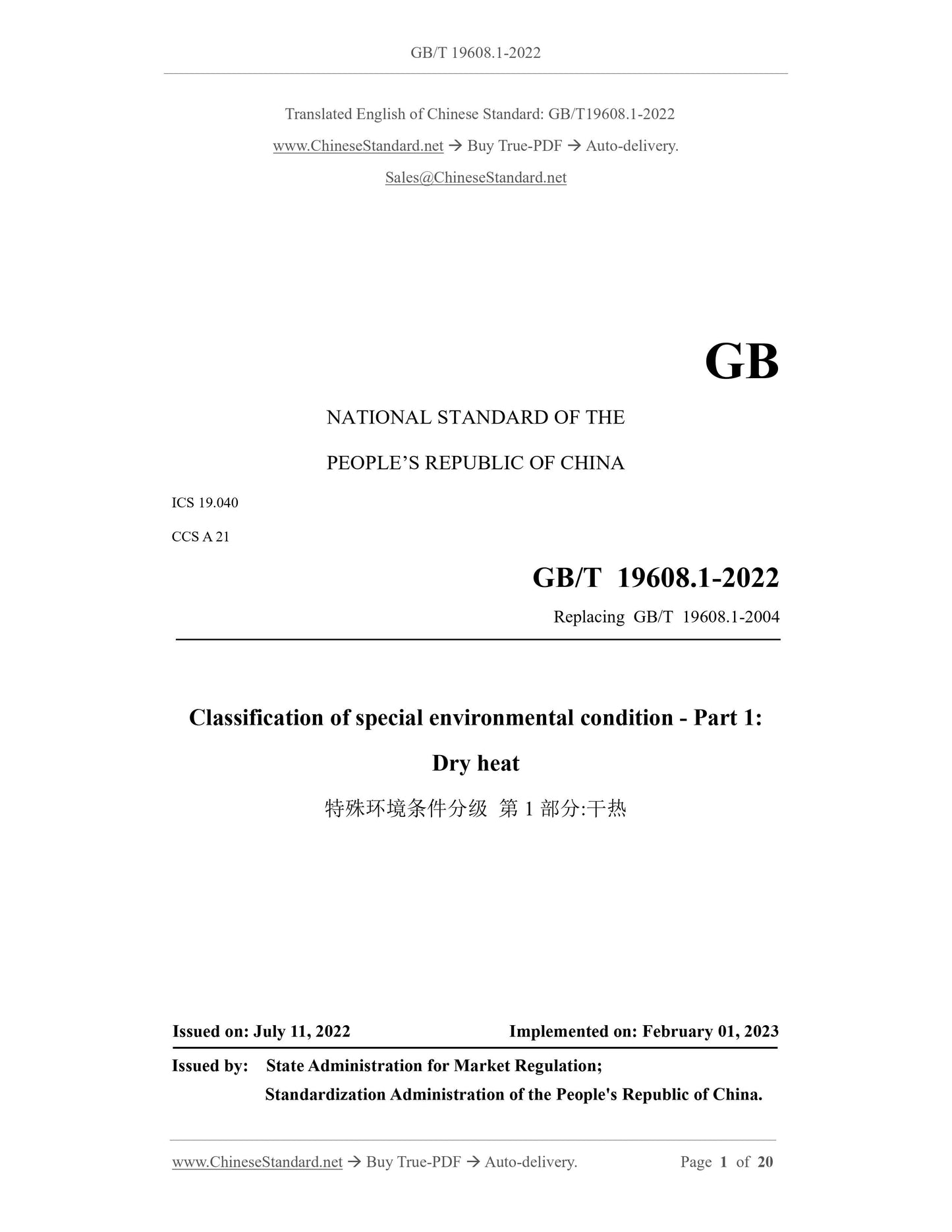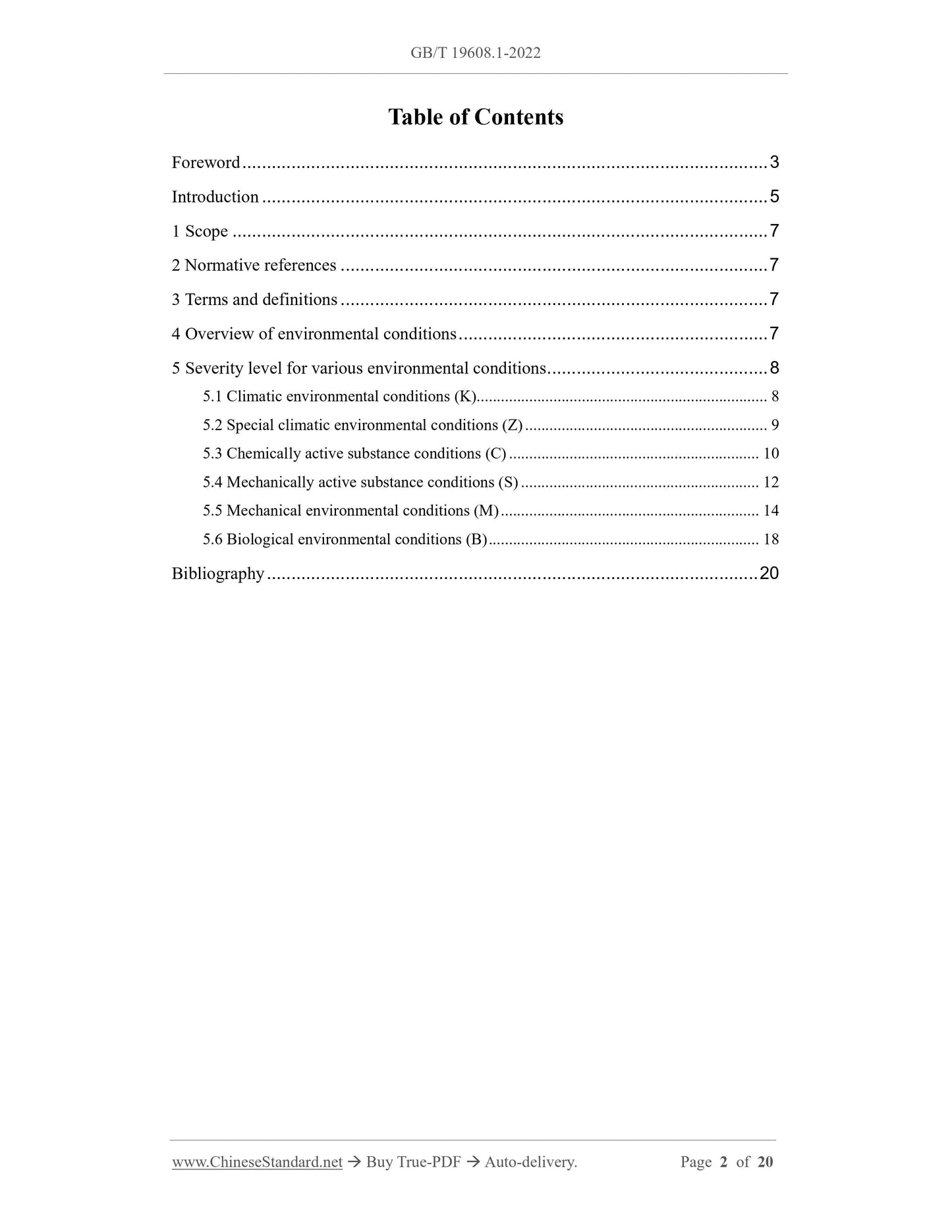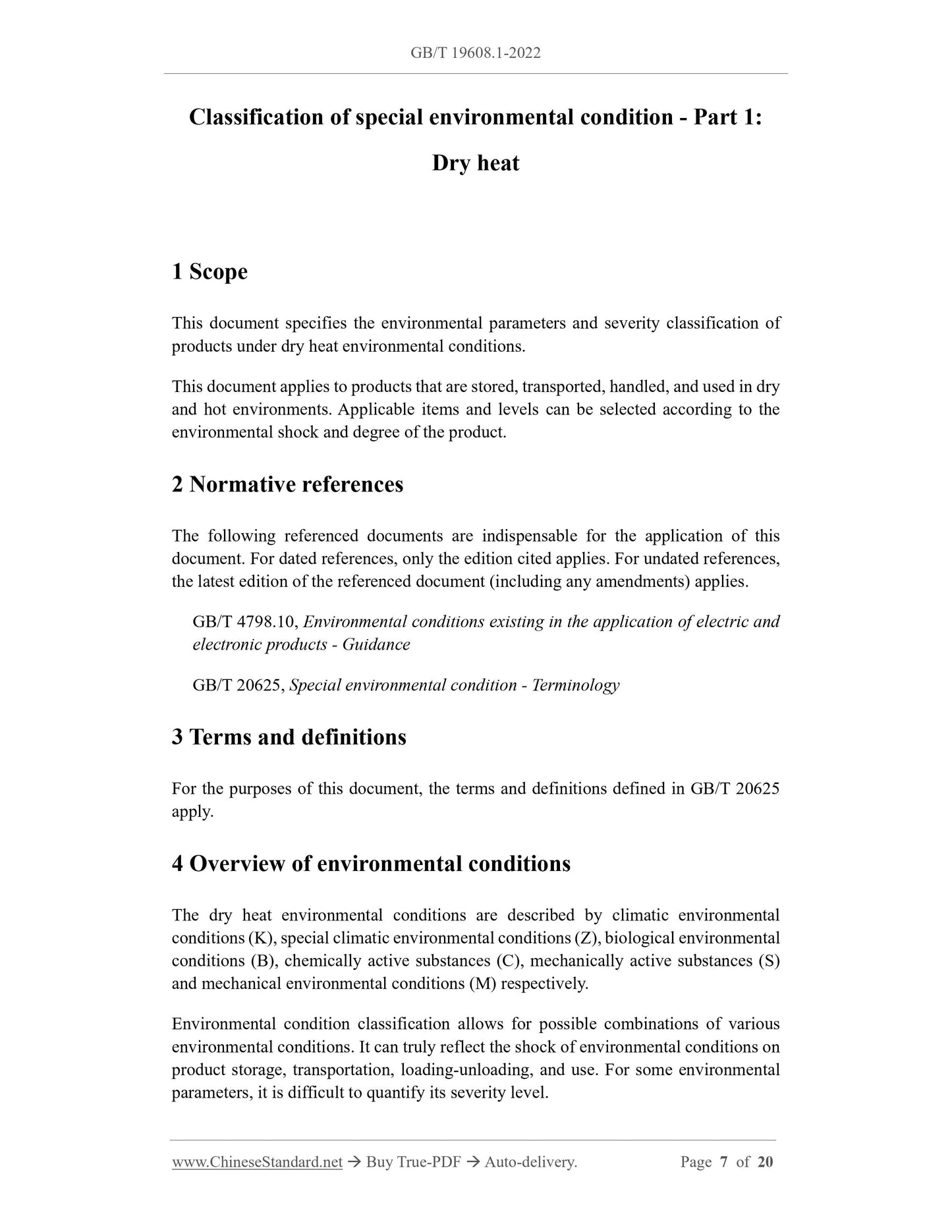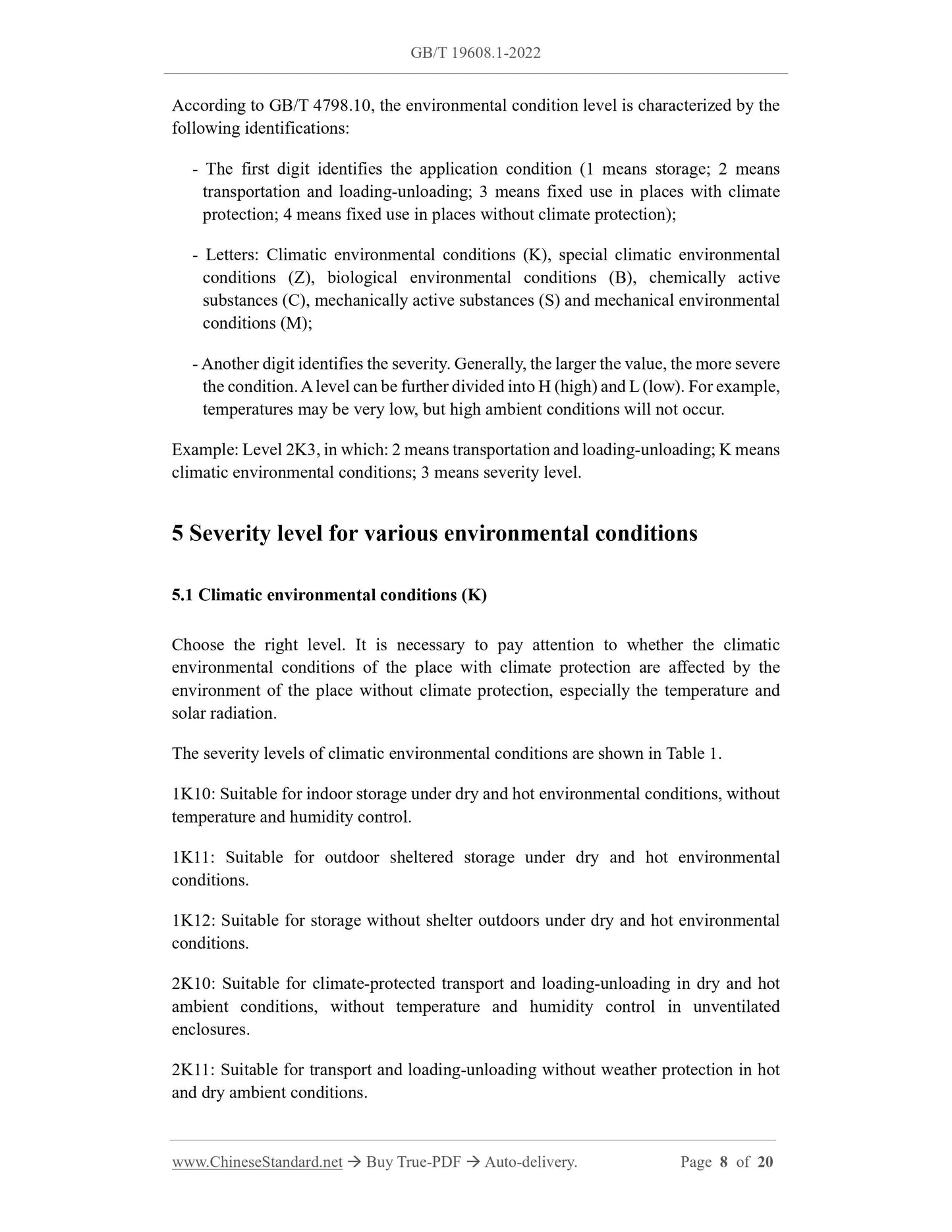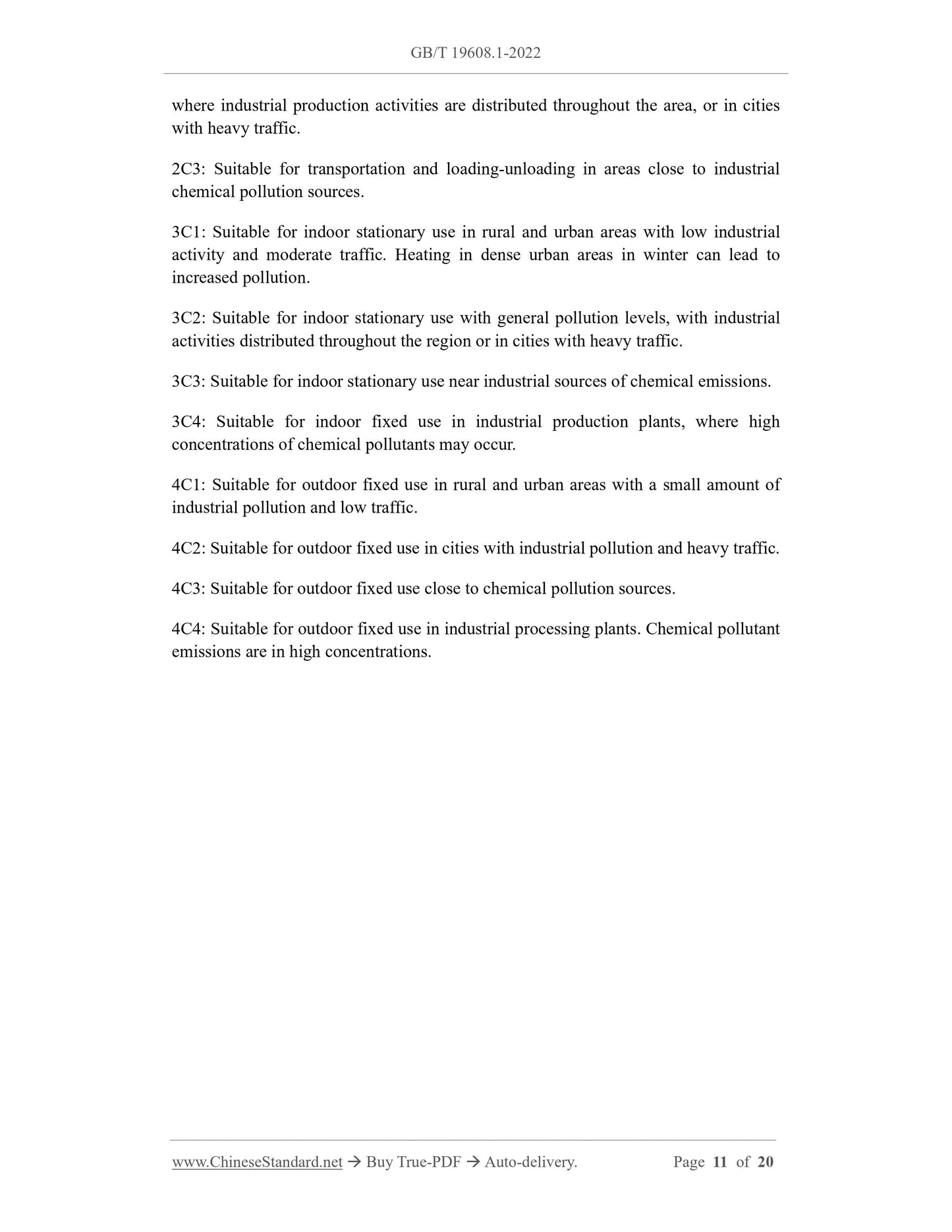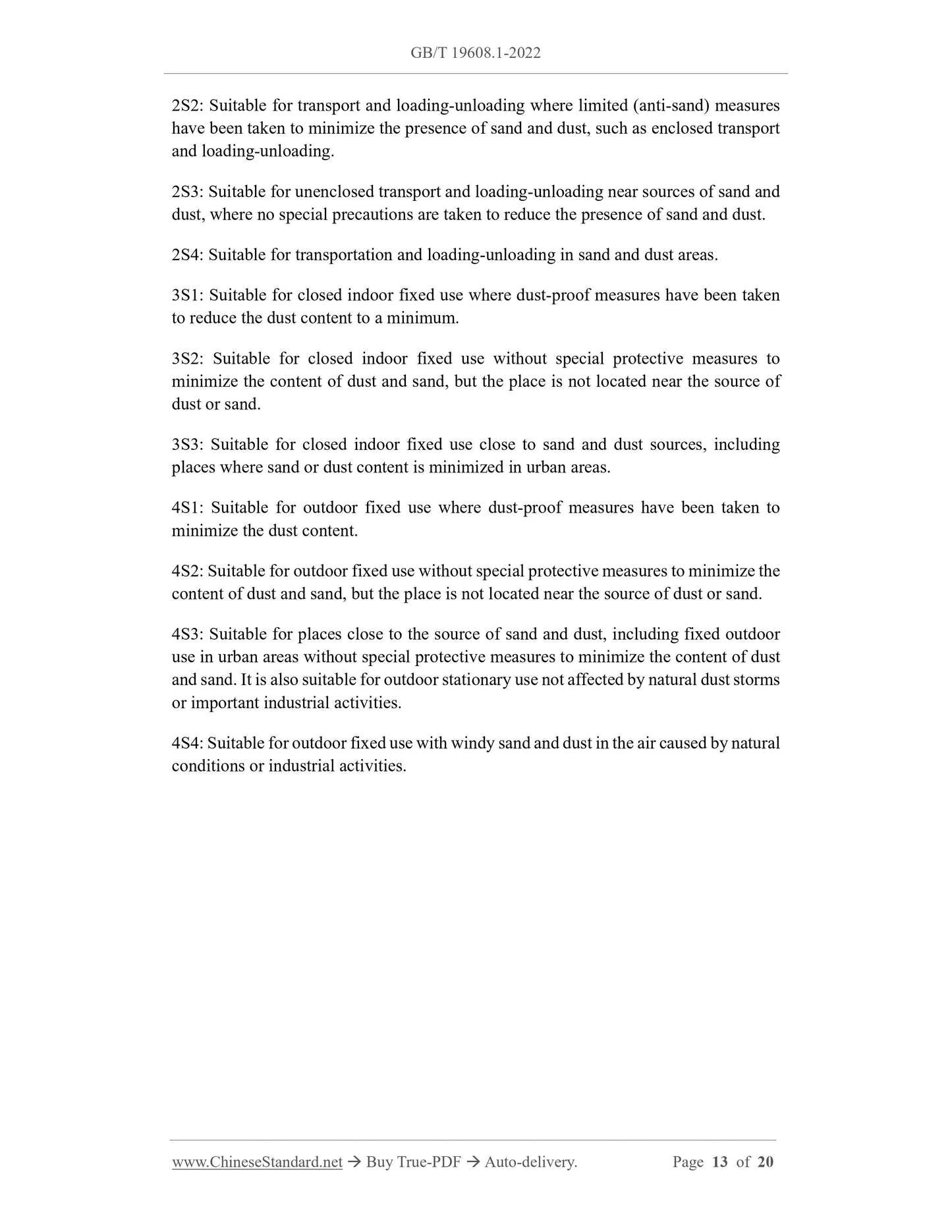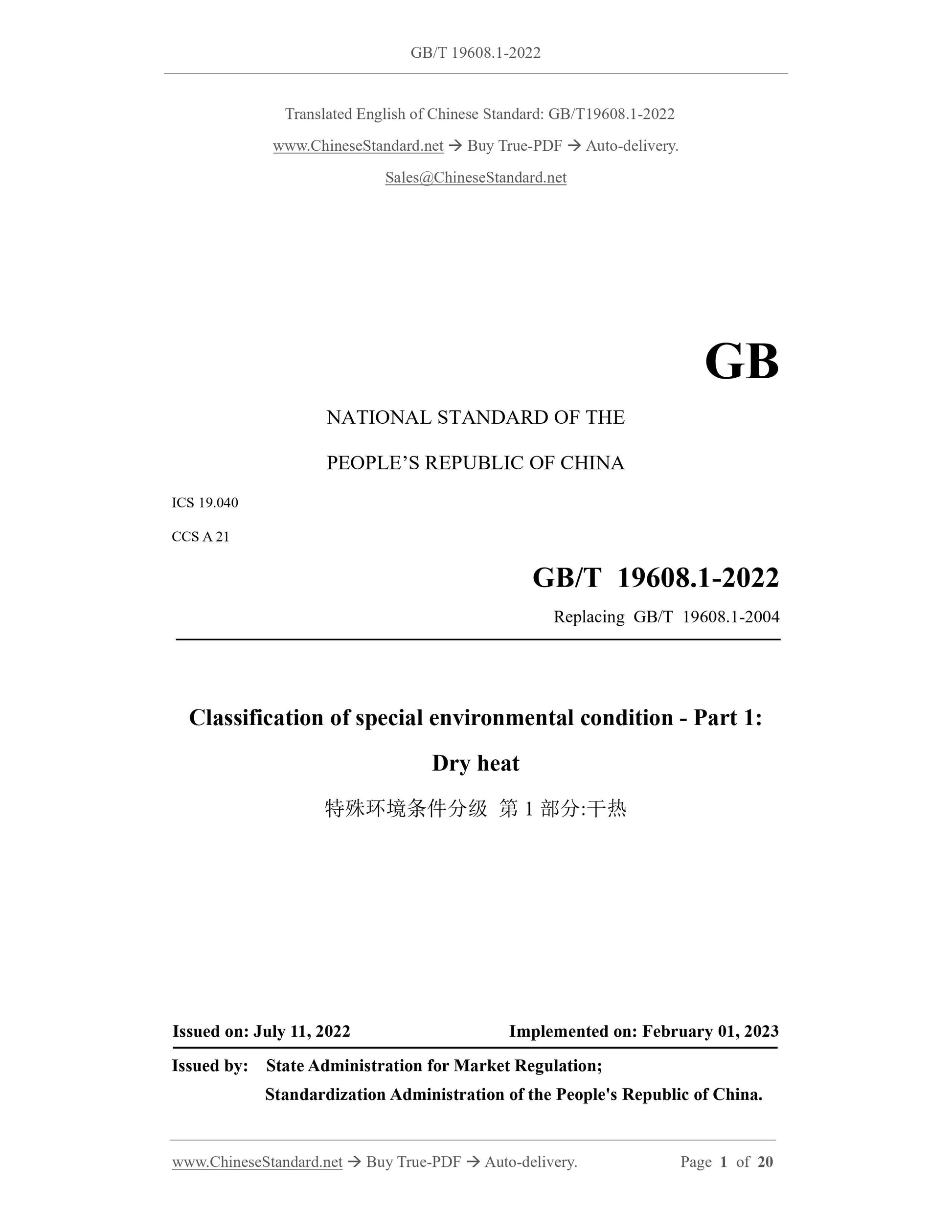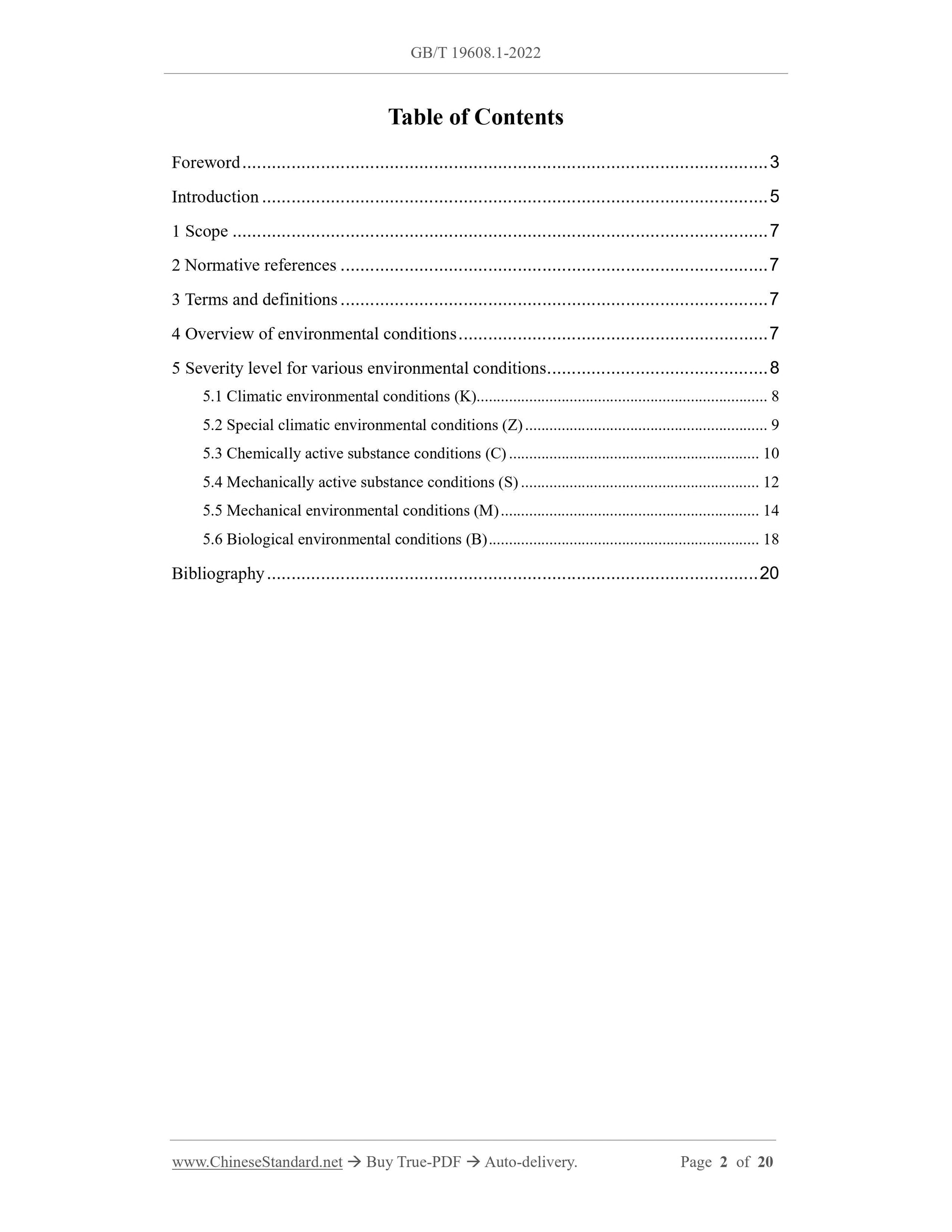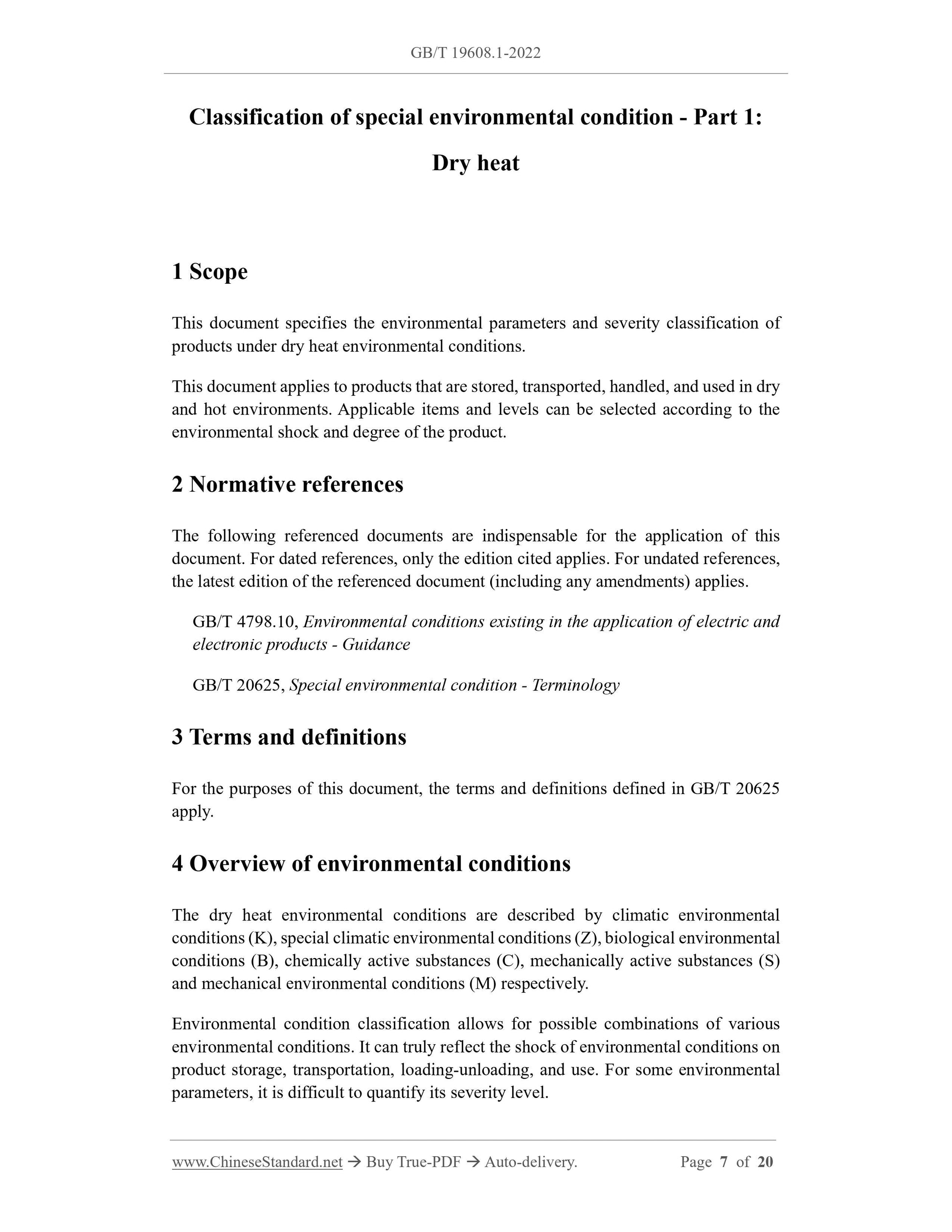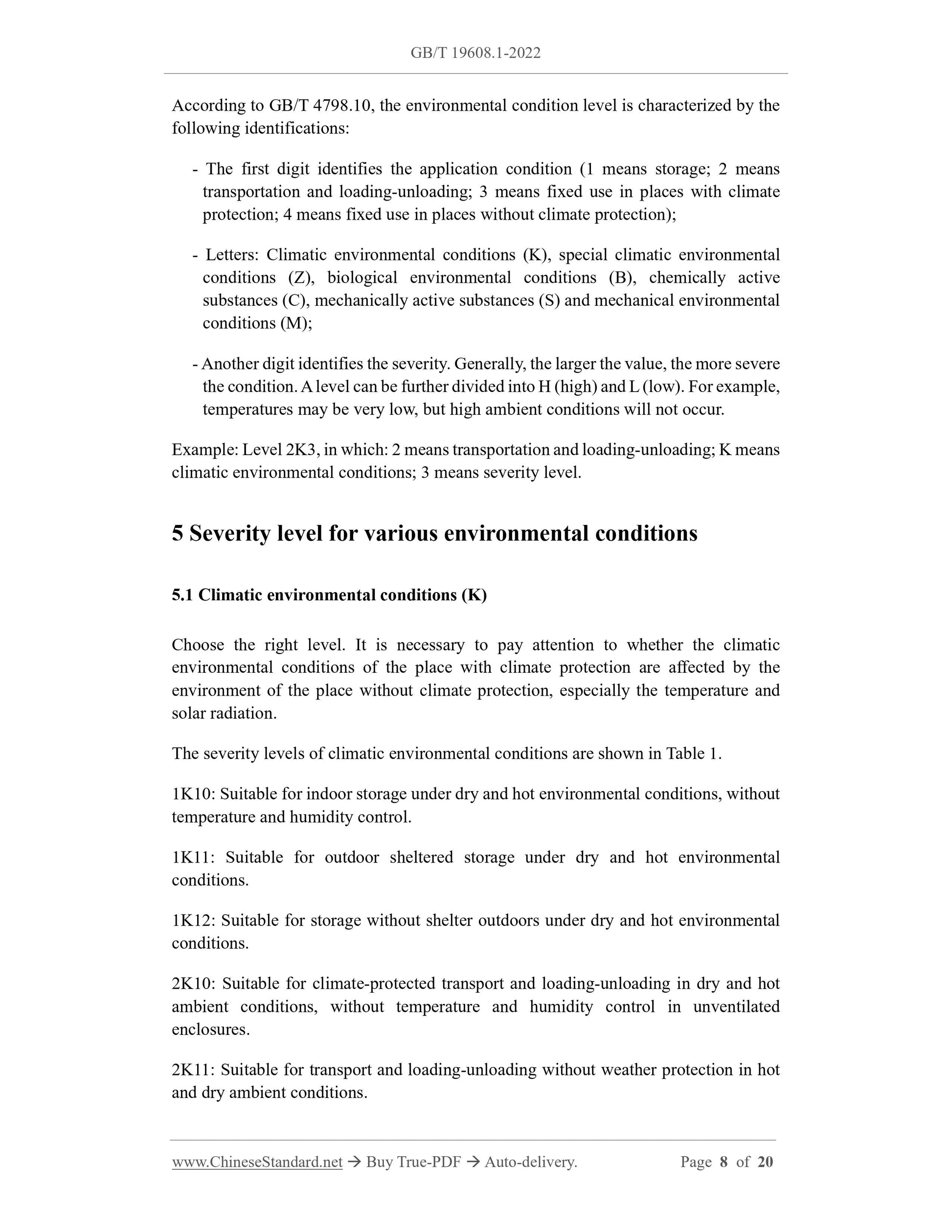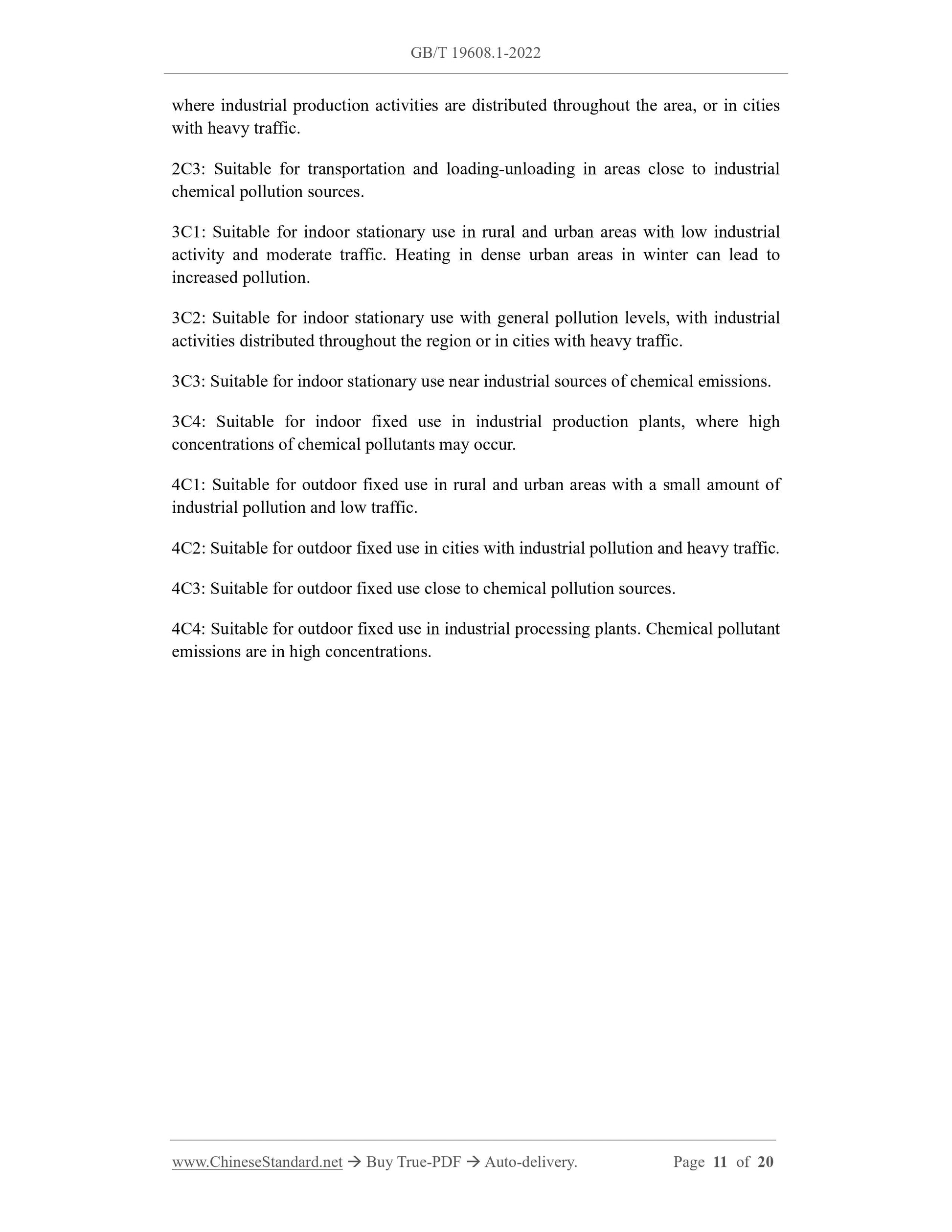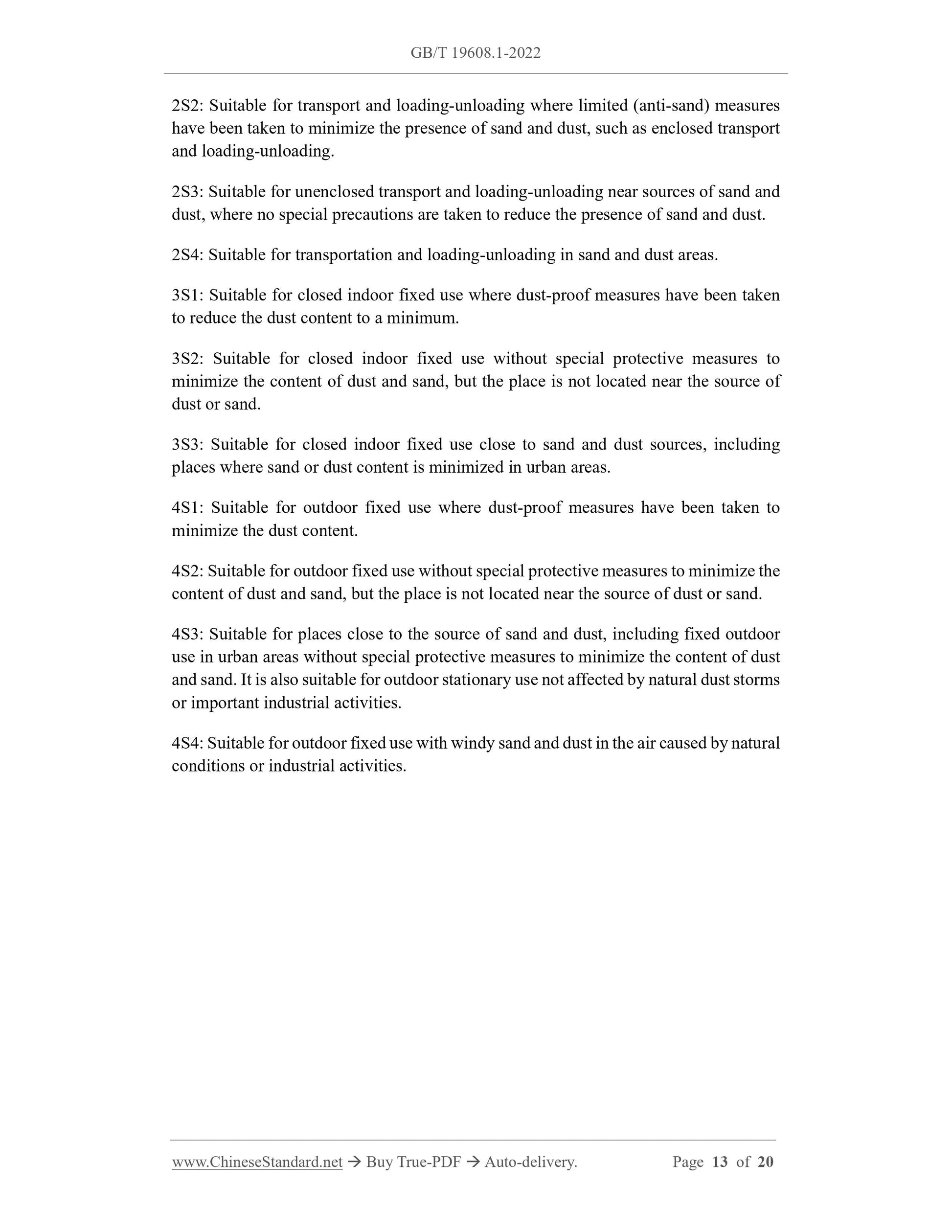1
/
of
6
PayPal, credit cards. Download editable-PDF & invoice In 1 second!
GB/T 19608.1-2022 English PDF (GBT19608.1-2022)
GB/T 19608.1-2022 English PDF (GBT19608.1-2022)
Regular price
$230.00 USD
Regular price
Sale price
$230.00 USD
Unit price
/
per
Shipping calculated at checkout.
Couldn't load pickup availability
Delivery: 3 seconds. Download true-PDF + Invoice.
Get QUOTATION in 1-minute: Click GB/T 19608.1-2022
Historical versions: GB/T 19608.1-2022
Preview True-PDF (Reload/Scroll if blank)
GB/T 19608.1-2022: Classification of special environmental condition - Part 1: Dry heat
GB/T 19608.1-2022
GB
NATIONAL STANDARD OF THE
PEOPLE’S REPUBLIC OF CHINA
ICS 19.040
CCS A 21
Replacing GB/T 19608.1-2004
Classification of special environmental condition - Part 1:
Dry heat
ISSUED ON: JULY 11, 2022
IMPLEMENTED ON: FEBRUARY 01, 2023
Issued by: State Administration for Market Regulation;
Standardization Administration of the People's Republic of China.
Table of Contents
Foreword ... 3
Introduction ... 5
1 Scope ... 7
2 Normative references ... 7
3 Terms and definitions ... 7
4 Overview of environmental conditions ... 7
5 Severity level for various environmental conditions ... 8
5.1 Climatic environmental conditions (K)... 8
5.2 Special climatic environmental conditions (Z) ... 9
5.3 Chemically active substance conditions (C) ... 10
5.4 Mechanically active substance conditions (S) ... 12
5.5 Mechanical environmental conditions (M) ... 14
5.6 Biological environmental conditions (B) ... 18
Bibliography ... 20
Classification of special environmental condition - Part 1:
Dry heat
1 Scope
This document specifies the environmental parameters and severity classification of
products under dry heat environmental conditions.
This document applies to products that are stored, transported, handled, and used in dry
and hot environments. Applicable items and levels can be selected according to the
environmental shock and degree of the product.
2 Normative references
The following referenced documents are indispensable for the application of this
document. For dated references, only the edition cited applies. For undated references,
the latest edition of the referenced document (including any amendments) applies.
GB/T 4798.10, Environmental conditions existing in the application of electric and
electronic products - Guidance
GB/T 20625, Special environmental condition - Terminology
3 Terms and definitions
For the purposes of this document, the terms and definitions defined in GB/T 20625
apply.
4 Overview of environmental conditions
The dry heat environmental conditions are described by climatic environmental
conditions (K), special climatic environmental conditions (Z), biological environmental
conditions (B), chemically active substances (C), mechanically active substances (S)
and mechanical environmental conditions (M) respectively.
Environmental condition classification allows for possible combinations of various
environmental conditions. It can truly reflect the shock of environmental conditions on
product storage, transportation, loading-unloading, and use. For some environmental
parameters, it is difficult to quantify its severity level.
According to GB/T 4798.10, the environmental condition level is characterized by the
following identifications:
- The first digit identifies the application condition (1 means storage; 2 means
transportation and loading-unloading; 3 means fixed use in places with climate
protection; 4 means fixed use in places without climate protection);
- Letters: Climatic environmental conditions (K), special climatic environmental
conditions (Z), biological environmental conditions (B), chemically active
substances (C), mechanically active substances (S) and mechanical environmental
conditions (M);
- Another digit identifies the severity. Generally, the larger the value, the more severe
the condition. A level can be further divided into H (high) and L (low). For example,
temperatures may be very low, but high ambient conditions will not occur.
Example: Level 2K3, in which: 2 means transportation and loading-unloading; K means
climatic environmental conditions; 3 means severity level.
5 Severity level for various environmental conditions
5.1 Climatic environmental conditions (K)
Choose the right level. It is necessary to pay attention to whether the climatic
environmental conditions of the place with climate protection are affected by the
environment of the place without climate protection, especially the temperature and
solar radiation.
The severity levels of climatic environmental conditions are shown in Table 1.
1K10: Suitable for indoor storage under dry and hot environmental conditions, without
temperature and humidity control.
1K11: Suitable for outdoor sheltered storage under dry and hot environmental
conditions.
1K12: Suitable for storage without shelter outdoors under dry and hot environmental
conditions.
2K10: Suitable for climate-protected transport and loading-unloading in dry and hot
ambient conditions, without temperature and humidity control in unventilated
enclosures.
2K11: Suitable for transport and loading-unloading without weather protection in hot
and dry ambient conditions.
where industrial production activities are distributed throughout the area, or in cities
with heavy traffic.
2C3: Suitable for transportation and loading-unloading in areas close to industrial
chemical pollution sources.
3C1: Suitable for indoor stationary use in rural and urban areas with low industrial
activity and moderate traffic. Heating in dense urban areas in winter can lead to
increased pollution.
3C2: Suitable for indoor stationary use with general pollution levels, with industrial
activities distributed throughout the region or in cities with heavy traffic.
3C3: Suitable for indoor stationary use near industrial sources of chemical emissions.
3C4: Suitable for indoor fixed use in industrial production plants, where high
concentrations of chemical pollutants may occur.
4C1: Suitable for outdoor fixed use in rural and urban areas with a small amount of
industrial pollution and low traffic.
4C2: Suitable for outdoor fixed use in cities with industrial pollution and heavy traffic.
4C3: Suitable for outdoor fixed use close to chemical pollution sources.
4C4: Suitable for outdoor fixed use in industrial processing plants. Chemical pollutant
emissions are in high concentrations.
2S2: Suitable for transport and loading-unloading where limited (anti-sand) measures
have been taken to minimize the presence of sand and dust, such as enclosed transport
and loading-unloading.
2S3: Suitable for unenclosed transport and loading-unloading near sources of sand and
dust, where no special precautions are taken to reduce the presence of sand and dust.
2S4: Suitable for transportation and loading-unloading in sand and dust areas.
3S1: Suitable for closed indoor fixed use where dust-proof measures have been taken
to reduce the dust content to a minimum.
3S2: Suitable for closed indoor fixed use without special protective measures to
minimize the content of dust and sand, but the place is not located near the source of
dust or sand.
3S3: Suitable for closed indoor fixed use close to sand and dust sources, including
places where sand or dust content is minimized in urban areas.
4S1: Suitable for outdoor fixed use where dust-proof measures have been taken to
minimize the dust content.
4S2: Suitable for outdoor fixed use without special protective measures to minimize the
content of dust and sand, but the place is not located near the source of dust or sand.
4S3: Suitable for places close to the source of sand and dust, including fixed outdoor
use in urban areas without special protective measures to minimize the content of dust
and sand. It is also suitable for outdoor stationary use not affected by natural dust storms
or important industrial activities.
4S4: Suitable for outdoor fixed use with windy sand and dust in t...
Get QUOTATION in 1-minute: Click GB/T 19608.1-2022
Historical versions: GB/T 19608.1-2022
Preview True-PDF (Reload/Scroll if blank)
GB/T 19608.1-2022: Classification of special environmental condition - Part 1: Dry heat
GB/T 19608.1-2022
GB
NATIONAL STANDARD OF THE
PEOPLE’S REPUBLIC OF CHINA
ICS 19.040
CCS A 21
Replacing GB/T 19608.1-2004
Classification of special environmental condition - Part 1:
Dry heat
ISSUED ON: JULY 11, 2022
IMPLEMENTED ON: FEBRUARY 01, 2023
Issued by: State Administration for Market Regulation;
Standardization Administration of the People's Republic of China.
Table of Contents
Foreword ... 3
Introduction ... 5
1 Scope ... 7
2 Normative references ... 7
3 Terms and definitions ... 7
4 Overview of environmental conditions ... 7
5 Severity level for various environmental conditions ... 8
5.1 Climatic environmental conditions (K)... 8
5.2 Special climatic environmental conditions (Z) ... 9
5.3 Chemically active substance conditions (C) ... 10
5.4 Mechanically active substance conditions (S) ... 12
5.5 Mechanical environmental conditions (M) ... 14
5.6 Biological environmental conditions (B) ... 18
Bibliography ... 20
Classification of special environmental condition - Part 1:
Dry heat
1 Scope
This document specifies the environmental parameters and severity classification of
products under dry heat environmental conditions.
This document applies to products that are stored, transported, handled, and used in dry
and hot environments. Applicable items and levels can be selected according to the
environmental shock and degree of the product.
2 Normative references
The following referenced documents are indispensable for the application of this
document. For dated references, only the edition cited applies. For undated references,
the latest edition of the referenced document (including any amendments) applies.
GB/T 4798.10, Environmental conditions existing in the application of electric and
electronic products - Guidance
GB/T 20625, Special environmental condition - Terminology
3 Terms and definitions
For the purposes of this document, the terms and definitions defined in GB/T 20625
apply.
4 Overview of environmental conditions
The dry heat environmental conditions are described by climatic environmental
conditions (K), special climatic environmental conditions (Z), biological environmental
conditions (B), chemically active substances (C), mechanically active substances (S)
and mechanical environmental conditions (M) respectively.
Environmental condition classification allows for possible combinations of various
environmental conditions. It can truly reflect the shock of environmental conditions on
product storage, transportation, loading-unloading, and use. For some environmental
parameters, it is difficult to quantify its severity level.
According to GB/T 4798.10, the environmental condition level is characterized by the
following identifications:
- The first digit identifies the application condition (1 means storage; 2 means
transportation and loading-unloading; 3 means fixed use in places with climate
protection; 4 means fixed use in places without climate protection);
- Letters: Climatic environmental conditions (K), special climatic environmental
conditions (Z), biological environmental conditions (B), chemically active
substances (C), mechanically active substances (S) and mechanical environmental
conditions (M);
- Another digit identifies the severity. Generally, the larger the value, the more severe
the condition. A level can be further divided into H (high) and L (low). For example,
temperatures may be very low, but high ambient conditions will not occur.
Example: Level 2K3, in which: 2 means transportation and loading-unloading; K means
climatic environmental conditions; 3 means severity level.
5 Severity level for various environmental conditions
5.1 Climatic environmental conditions (K)
Choose the right level. It is necessary to pay attention to whether the climatic
environmental conditions of the place with climate protection are affected by the
environment of the place without climate protection, especially the temperature and
solar radiation.
The severity levels of climatic environmental conditions are shown in Table 1.
1K10: Suitable for indoor storage under dry and hot environmental conditions, without
temperature and humidity control.
1K11: Suitable for outdoor sheltered storage under dry and hot environmental
conditions.
1K12: Suitable for storage without shelter outdoors under dry and hot environmental
conditions.
2K10: Suitable for climate-protected transport and loading-unloading in dry and hot
ambient conditions, without temperature and humidity control in unventilated
enclosures.
2K11: Suitable for transport and loading-unloading without weather protection in hot
and dry ambient conditions.
where industrial production activities are distributed throughout the area, or in cities
with heavy traffic.
2C3: Suitable for transportation and loading-unloading in areas close to industrial
chemical pollution sources.
3C1: Suitable for indoor stationary use in rural and urban areas with low industrial
activity and moderate traffic. Heating in dense urban areas in winter can lead to
increased pollution.
3C2: Suitable for indoor stationary use with general pollution levels, with industrial
activities distributed throughout the region or in cities with heavy traffic.
3C3: Suitable for indoor stationary use near industrial sources of chemical emissions.
3C4: Suitable for indoor fixed use in industrial production plants, where high
concentrations of chemical pollutants may occur.
4C1: Suitable for outdoor fixed use in rural and urban areas with a small amount of
industrial pollution and low traffic.
4C2: Suitable for outdoor fixed use in cities with industrial pollution and heavy traffic.
4C3: Suitable for outdoor fixed use close to chemical pollution sources.
4C4: Suitable for outdoor fixed use in industrial processing plants. Chemical pollutant
emissions are in high concentrations.
2S2: Suitable for transport and loading-unloading where limited (anti-sand) measures
have been taken to minimize the presence of sand and dust, such as enclosed transport
and loading-unloading.
2S3: Suitable for unenclosed transport and loading-unloading near sources of sand and
dust, where no special precautions are taken to reduce the presence of sand and dust.
2S4: Suitable for transportation and loading-unloading in sand and dust areas.
3S1: Suitable for closed indoor fixed use where dust-proof measures have been taken
to reduce the dust content to a minimum.
3S2: Suitable for closed indoor fixed use without special protective measures to
minimize the content of dust and sand, but the place is not located near the source of
dust or sand.
3S3: Suitable for closed indoor fixed use close to sand and dust sources, including
places where sand or dust content is minimized in urban areas.
4S1: Suitable for outdoor fixed use where dust-proof measures have been taken to
minimize the dust content.
4S2: Suitable for outdoor fixed use without special protective measures to minimize the
content of dust and sand, but the place is not located near the source of dust or sand.
4S3: Suitable for places close to the source of sand and dust, including fixed outdoor
use in urban areas without special protective measures to minimize the content of dust
and sand. It is also suitable for outdoor stationary use not affected by natural dust storms
or important industrial activities.
4S4: Suitable for outdoor fixed use with windy sand and dust in t...
Share
